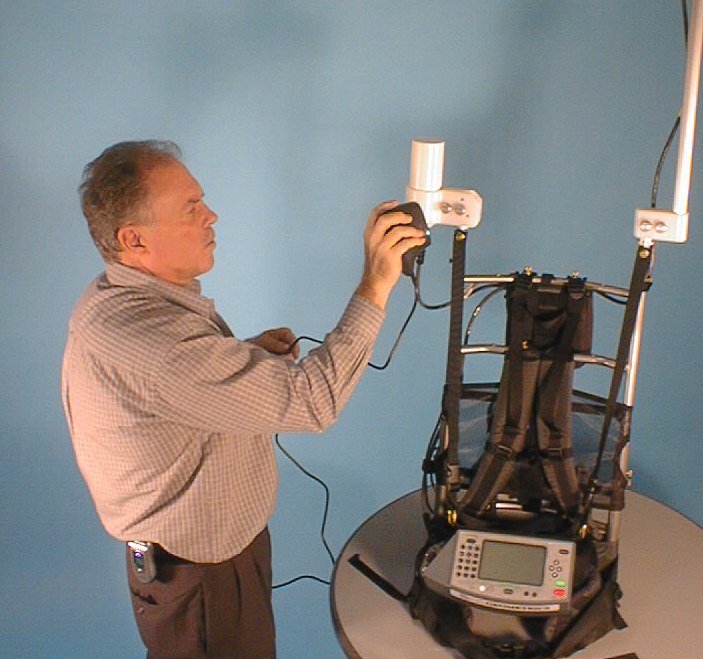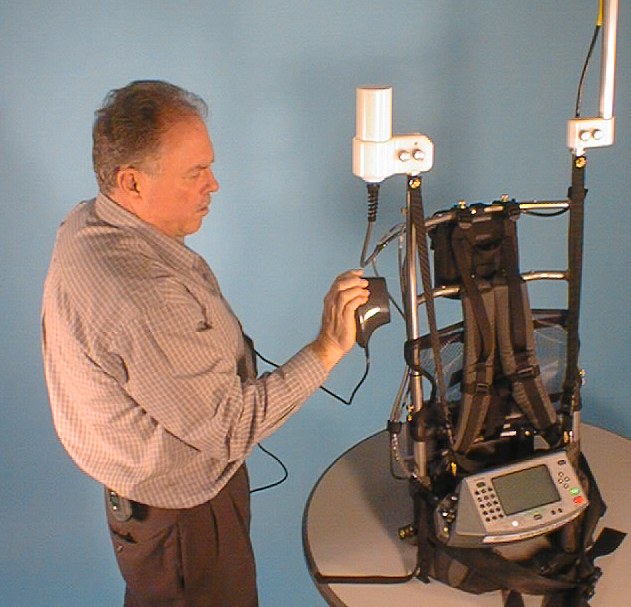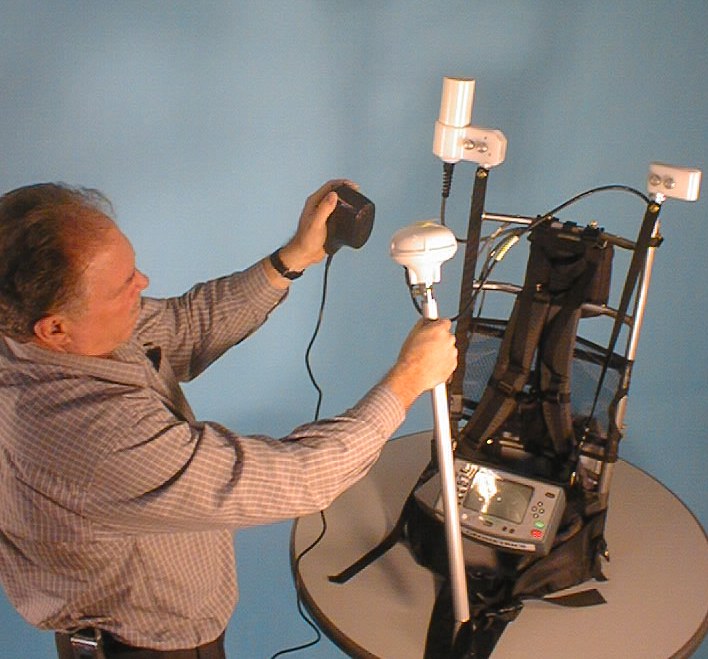Degaussing is a method by which magnetic domains in metals or magnetic inclusions in other materials are randomized so that net magnetization is minimized. One tool do accomplish this is the “Bulk Tape Eraser” designed to erase data tapes.
The method works because the “Bulk Tape Eraser” generates an alternating electromagnetic field, which flips the magnetization of the magnetic domains in the material at 100 or 120 reversals per second (50 or 60 hertz). As the operator slowly removes the “Eraser” from the vicinity of the magnetized material, the magnetic domains of the material individually freeze in one orientation or the other, leaving the domains in a randomized orientation with minimal net magnetic effect.
Degaussing with a Bulk Tape Eraser
- The procedure is straight forward. Plug the Eraser into an extension cord or wall socket (the Eraser cord is usually short). Holding the object to be degaussed in one hand, depress the Eraser start button and move it towards the object. Once close to the object or section of material, begin moving the Eraser with a small circular motion and then increase the radius of the circle as you draw the Eraser away from the object. DO NOT STOP the Eraser closer than three feet from the object being degaussed or it will become strongly magnetized in one direction! If this happens accidentally, just redo the degaussing procedure over again starting from the beginning.
- For larger objects, run the Eraser along tubing or struts in a circular motion to “bathe” the objects in an oscillating field. Be sure to cover the entire surface area of the object being degaussed. Then slowly withdraw the eraser (while still running) until it is at least 3 feet away. Then release the power switch.
- The magnetometer can be used to check the sufficiency of the degaussing procedure. After degaussing, rotate the object close to an operating magnetometer to see if there is a response from the magnetometer. This is best done with a cesium magnetometer operated in gradient mode, but it can be done with a single sensor with one person watching the result and another moving the object near the sensor.

Degaussing Sensor Mount

Degaussing Pack Frame

Degaussing GPS Antenna
Limitations of Degaussing with a Bulk Eraser
- Depth of penetration: The Bulk Tape Eraser can only randomize materials to a certain depth. This is due to the size of the gap in the degaussing unit. A small gap makes for a very large degaussing field at the gap (about 2000 gauss, or 200 million nanoteslas), but also for a very rapid falloff away from the gap. Bulk tape erasers are optimized to penetrate through the thickness of a typical video tape. This gives a typical depth of an inch (2.5 cm). Deeper objects may need to be degaussed using stronger degaussing fields.
- Degaussing through a conductive chassis: An additional problem occurs when the object being degaussed is covered by a conductive surface (such as a sheet of aluminum). The degaussing field will generate huge eddy currents in the conductive surface which will generate its own opposing magnetic field. This will be evident to the operator because the opposing field will cause the degausser to buzz loudly. This doesn’t hurt anything, but be aware that the degaussing field on the other side of the conductive surface will be attenuated by some amount, so it may take a longer amount of time or multiple passes to degauss the object.
- The Bulk Tape Eraser is a short duty cycle device. It varies a little from manufacturer to manufacturer, but typically it is rated for 1 minute on and 5 to 10 minutes off. Most have an internal thermal cutout that will shut it off if it overheats, and if tripped may take 20 minutes or more to cool down enough to reset.
Frequently Asked Questions
Why is degaussing needed? Degaussing misaligns magnetic domains so that there is no net permanent magnetization that would give an offset or heading error to magnetic field readings. Sensitive magnetometers such as those manufactured by Geometrics can be effected by nearby materials that are not sufficiently magnetically randomized. Degaussing does not alter the induced magnetic moment of any material. A piece of steel, when degaussed, is still magnetic because it draws and concentrates the earth’s field through it. However, a degaussed piece of steel is much less magnetic than a permanently magnetized piece.
How much effect does it have on magnetic signatures? Depending on the distance from the sensor to the magnetic object and the amount of magnetization, the effects can be very large -10’s of nanoTeslas. Many materials including brass, aluminum, fiberglass and other non-ferrous materials may have some ferrous materials in them naturally or acquired during the manufacturing process. Other materials such as ‘non-magnetic’ stainless steel are hugely magnetic when compared to the sensitivity of our magnetometers. Degaussing can decrease the magnetic effect of these materials by a factor of 10 or more.
What should I degauss? The operator should degauss any metallic object that is near the sensor. By “near”, in general we mean within 1 meter but certainly those metallic and non-metallic materials within a few centimeters of the sensor must be considered (this also includes the sensor itself, which could have minute magnetic inclusions in the sensor materials). This could also include GPS antennas, magnetometer cart assemblies (including brass fittings, bolts, clamps), buckles, eyeglasses, boots and parts of backpacks. We would also do occasional degaussing of the G-858 console and batteries.
Will degaussing hurt anything? This is a tough question since it is impossible to imagine every conceivable system arrangement that could be subjected to degaussing. In all our experience we have never had any electronics device hurt by the degaussing process. This is because the induced voltages from the degausser are low, and the electronics components have a fairly high impedance at low voltages. It would be safer to degauss electronics while the power to the electronics is turned off in case the small induced voltages cause the device to operate incorrectly. It is always safe to degauss any of Geometrics’ manufactured equipment (including the sensor). On the other hand, here are some things to consider when degaussing some types of objects. Large conductive planes or rings will have large circulating currents induced in them by the degausser (but the voltages are still very small). This induced current will produce an opposing magnetic field that will fight the degaussing field – causing both the degausser and the conductive plane/loop to vibrate substantially. If the device being degaussed is sensitive to this vibration (intricate mechanical workings and the like) then this is a possible route for causing some damage. Also, sometimes objects being degaussed have embedded magnets that are necessary for the device to operate properly. A good example is a device with a permanent magnet speaker inside. Generally it is hard to degauss a magnetically hard permanent magnet, but the degausser is strong enough to at least partially do the job. A partially degaussed speaker (or other object that requires a magnet to work right) isn’t going to work the same as before – so be aware. [Things that have magnets in them shouldn’t be used near magnetometers anyway.]
When to degauss and how often? We recommend that parts close to the sensor be degaussed before every major survey event. In other words on a weekly or monthly basis or before a new survey. Remnant magnetism or “Perm” can be “picked up” (domains realigned) when the materials are static in the earth’s magnetic field for a period of time. The amount of time required to acquire a “Perm” can be from days to weeks or months depending on the magnetic “hardness” of the materials. This is also known as the materials “susceptibility”, that is, susceptibility to being magnetized. Also, magnets are everywhere, and they can easily and unknowingly ‘perm’ up parts on or near the sensor. Magnetic screwdrivers, for example, are great for holding steel screws on the end of the driver while starting them into a threaded hole, but they are bad news near any magnetometer sensors.
